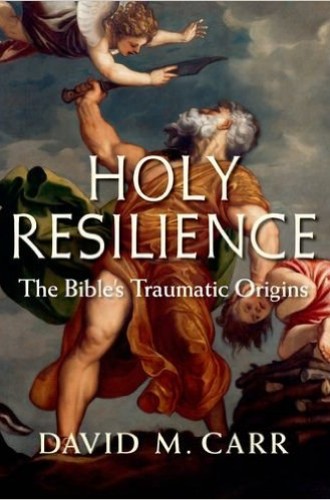Post-traumatic texts
Since the 19th century, biblical study has accepted history as its defining cognate discipline. History has dictated the questions asked of the text, whether by fundamentalists who find the whole Bible to be historical, or by minimalists who want little of it to be historical, or by the Jesus Seminar with its circular arguments, or by historical criticism in general.
At the turn of the last century, however, the unquestioned mastery of history as the defining cognate discipline for biblical study was being challenged by the rise of social scientific methods that ask other kinds of questions of the text, not eliminating historical questions but breaking the monopoly of such investigation. Among the great variety of newer cognate disciplines has been trauma studies, which arose in the 20th century in response to the deep and multiple traumas leading to posttraumatic stress disorder, with its “story of a wound that cries out.” Given that compelling body of research into the searing experiences of disaster in the 20th century, it is inevitable that trauma studies should become a fresh cognate discipline for scripture, as evidenced in the work of Daniel Smith-Christopher and Kathleen O’Connor.
Read our latest issue or browse back issues.
David Carr, professor of Old Testament at Union Theological Seminary in New York, rereads the familiar materials of the Bible in light of trauma theory and opens the way for a fresh and suggestive interpretation. He brings to the work his personal experience of a biking accident followed by months of healing and rehabilitation during which, he writes, “I barely lived.” His simple thesis, worked in many layers, is that scripture was formed over and over as a response of faith to deep historical trauma. The term resilience in his title refers to the capacity of communities of faith to continue in the face of disaster.
Carr judges that the founding of the monarchies of Judah and northern Israel brought a political system of writing that became “the pretraumatic core of the Old Testament” in the assertion of the first scripture. The monarchy’s introduction of writing, a “thing for enemy city-state monarchies,” and thus the first scripture, was an intrusion into the oral tradition of the tribes of Israel.
But then came the generative force of trauma. In the first wave of such generativity, the process is clear enough:
- The destruction of the Northern Kingdom evoked Hosea’s prophecy of hope and judgment as scripture. The image of divine-human marriage was an attempt to process imperial trauma.
- The Assyrian crisis in the times of Hezekiah and Josiah produced the Deuteronomic corpus as a response to destructive loss.
- The destruction of Jerusalem at the hands of the Babylonians produced the trauma literature of Lamentations, Jeremiah, Ezekiel, and eventually the exilic “comfort” of 2 Isaiah.
After that the argument becomes more complex as Carr ponders other textual responses to the trauma of exile. He proposes that the Pentateuchal materials concerning Abraham and Moses were taken up as fresh resources for resistance.
Historian that he is, Carr is careful not to claim that these traditions were invented in the sixth century, as some have proposed:
Of course one cannot rule out that the historical Abraham, the one who lived, actually underwent challenges like those described in Genesis. Perhaps it is just lucky happenstance that these stories about him turned out to comfort later traumatized generations. Whatever its origin, the Genesis story of Abraham was revised in light of trauma for people in trauma.
The biblical narrative became an antidote to the crisis of exile. While parts of the Moses story “long predate the Babylonian exile,” that story, culminating in Passover, became a great source of assurance and hope for traumatized Israel. The crisis of the exile eventuated in the deeply Torah-oriented movement led by Ezra that made possible the survival of a remnant that understood itself as chosen, not in triumph but in diligent obedience.
Carr provides a brief but crucial segue to the New Testament by considering the crisis of Hellenization and the aggressive initiatives of Antiochus IV that evoked the Hasmonaean standardization of the Hebrew scriptures. Indeed, the form of the text, fixed in this period as a resource for resistance against Hellenization, yields a textual tradition that came to be normative for times to come. Canon is a response of resistance to the threat of Antiochus IV!
In the remainder of the book, Carr extends his thesis into the New Testament. He judges that the development of Christian scripture was a response to Rome’s attempt to obliterate the Jesus movement, an attempt that pivoted on the execution of Jesus. But the scandal of execution became the hallmark of Christian faith:
Jesus’ crucifixion became the founding event of the movement and not its end. . . . The cross is no sign of humiliating defeat for Christians. Instead, it is a proud symbol of movement membership. Jesus’ followers did not end up fleeing from the reality of his crucifixion, but “took up the cross” themselves. Such a thing would have been incomprehensible to Romans. It is an excellent example of the adaptability of symbols, especially in cases like imperial domination, where a dominated group confronts symbolic actions imposed on it by the oppressor. The Roman symbol of ultimate defeat became the Christian symbol of ultimate victory.
Carr proposes that Jesus died sacrificially not to assuage an angry God, but to walk to the threshold of salvation where his followers could follow. This opening made possible by Jesus is like that of Moses, who led to the edge of the land of promise. Carr’s suggestive movement between the Moses narrative and the Servant Song of Isaiah 53 reflects the imaginative interpretation that permitted the early Jesus movement to persist in the face of Rome: “The cross that Romans intended to bring despair instead became a beacon of hope.”
The discussion is carried further by a consideration of Paul, “the traumatized apostle.” Paul faced the trauma of his own conversion as he struggled between a persecuting past and an apostolic future. Beyond that, Paul took his own trauma as a paradigm for Christian living. The Christian movement was summoned to a new life that was wrought out of the trauma of the crucifixion. The direct linkage of the trauma of crucifixion to the Christian movement permits Carr to comment on the resurrection. His words sound like my seminary teacher who taught us that “the reality of the church is the verification of the resurrection”:
The church’s survival, its ongoing life and flourishing, became a testimony to the healing and making righteous that Jesus’ death accomplished. Not only Jesus but the whole community, the whole Jesus movement, stands as proof of the failure of Roman imperial terrorism.
Carr carefully reflects on the destruction of Jerusalem and its temple by the Romans, which became the matrix for both Rabbinic Judaism and the Christian movement. Both were responses of faith to the threat of Rome, embraces of meaning and assurance that refused imperial containment and opened to larger, deeper possibility.
Particular attention is given to the Gospel of Mark with its abrupt ending without any report of resurrection appearances. Carr judges that this earliest response to the trauma of crucifixion was then augmented in other Gospels with resurrection scenes. The church was doing the hard work of continuing to make sense out of its narrative of trauma. Carr doesn’t say much about the resurrection, but he acknowledges its force in the Christian movement:
The gospels of Matthew, Luke, and John remedied this ending by adding stories about disciples actually seeing the resurrected Jesus. . . . References to the resurrection in Paul and other early writings indicate that Jesus Jews talked from an early point about encounters with Jesus on the other side of crucifixion. . . . These additions reflect the ongoing struggle of Jesus followers to place the trauma of Jesus’ crucifixion into a broader framework.
This rich alternative reading of the Bible is “saturated with trauma and survival of it.” Carr does not avoid questions of the historicity of the tradition, but it is clear that his interest is elsewhere.
Ours is a time of profound trauma about race, the economy, violence, and the environment. Just as the biblical text emerged in response to trauma, this may be an important time to let the text touch the power and pain of trauma yet again. Carr has provided an accessible guide for further work, and this new cognitive discipline for scripture study is sure to be of immense importance for some time to come.







